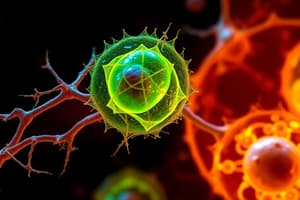Podcast
Questions and Answers
What is the primary function of the tonoplast in vacuoles?
What is the primary function of the tonoplast in vacuoles?
- Generating energy through ATP production
- Storing genetic information
- Facilitating photosynthesis
- Controlling the passage of water and chemicals (correct)
Which of the following statements MOST accurately describes mitochondria?
Which of the following statements MOST accurately describes mitochondria?
- Mitochondria are rod-like structures that can vary in size and generate energy through cellular respiration. (correct)
- Mitochondria have a single-layer membrane and are primarily found in plant cells.
- Mitochondria are only involved in the Krebs cycle and do not participate in the electron transport chain.
- Mitochondria contain chlorophyll and are responsible for converting light energy into chemical energy.
How do the cristae structures differ between plant and animal mitochondria?
How do the cristae structures differ between plant and animal mitochondria?
- Cristae in plant mitochondria are sheet-like, while in animal mitochondria they are tubular.
- Cristae are only present in animal mitochondria.
- Cristae in plant mitochondria are tubular or villus-like, while in animal mitochondria they are plate-like. (correct)
- Cristae are smooth in both plant and animal mitochondria.
What is the main role of chloroplasts in cells?
What is the main role of chloroplasts in cells?
Which of the following best describes the relationship described by the endosymbiotic theory?
Which of the following best describes the relationship described by the endosymbiotic theory?
Which function is not associated with lysosomes?
Which function is not associated with lysosomes?
What conditions are optimal for the enzymes found in lysosomes to function?
What conditions are optimal for the enzymes found in lysosomes to function?
Which of the following is a primary function of vacuoles in plant cells?
Which of the following is a primary function of vacuoles in plant cells?
Where are lysosomes formed in the cell?
Where are lysosomes formed in the cell?
Which statement about vacuoles is false?
Which statement about vacuoles is false?
Study Notes
Interior Structure of Cells
- Composed of cytoplasm, cytoskeleton (in eukaryotes), and organelles.
- Organelles are classified into three groups: endomembrane system, mitochondria and chloroplasts, ribosomes and nucleus.
Endomembrane System
Lysosomes
- Found in all animal cells and some plant cells, containing several hundred dark spherical bodies.
- Membrane-bound sacs filled with digestive enzymes, operating optimally at pH 5.
- Functions include:
- Intracellular digestion via enzymes such as lipases, carbohydrases, and proteases.
- Recycling old organelles through autophagy.
- Digesting remains of dead cells through autolysis.
- Formation process involves the RER assembling enzymes and membranes, followed by chemical refinement in the Golgi apparatus.
Vacuoles
- Membrane-enclosed fluid-filled sacs, prevalent in plant and fungal cells.
- Size can occupy 30% to 90% of cell volume.
- Functions include:
- Providing rigidity to plants via hydrostatic pressure.
- Storage of nutrients and chemicals.
- Breaking down complex molecules similarly to lysosomes in animal cells.
- Central vacuole enclosed by tonoplast, controlling chemical passage while allowing water to flow freely.
Mitochondria and Chloroplasts
- Both play a crucial role in energy production and contain their own DNA and ribosomes.
- Endosymbiotic theory suggests they originated from independent bacteria engulfed by larger cells.
Mitochondria
- Rod-like structures found in large numbers, especially in animal cells; dimensions range from 0.5-1.5µm wide and 3-10µm long.
- Double membrane structure: smooth outer membrane and infolded inner membrane (cristae) that partially divides the matrix.
- Primary function: ATP production through cellular respiration (Krebs cycle and electron transport chain).
- Animal and plant mitochondria differ in cristae shape: tubular in plants, sheet-like in animals.
Chloroplasts
- Large, flat discs averaging 5μm in diameter and 2.3μm thick, with 1 to 50 present per cell.
- Have their own DNA, RNA, and ribosomes, often containing starch granules and oil droplets.
- Main function: photosynthesis, converting light energy into sugars, facilitated by chlorophyll.
- Composed of double membranes, with internal structures (thylakoids) stacked into grana for light reaction site and embedded with photosynthetic pigments.
Ribosomes and Nucleus
Nucleus
- Largest organelle, approximately 6μm in size, encased in a double membrane punctuated by nuclear pores.
- Nuclear membrane limited permeability; nuclear pores allow selective movement of small molecules and ions.
- Functions as the cell's control center, regulating gene expression, DNA replication, and ribosome synthesis in the nucleolus.
Ribosomes
- Spherical granules measuring 20-25nm, comprised of RNA and proteins; consist of two subunits synthesized in the nucleolus.
- Eukaryotic ribosomes have a 80S structure (40S + 60S), while prokaryotic ribosomes are 70S (30S + 50S).
- Function: protein synthesis based on mRNA genetic information, synthesizing proteins for use within the cell or for export.
Protein Synthesis Process
- Genetic information transcribed from DNA to mRNA in the nucleus.
- mRNA exits the nucleus and attaches to ribosomes in the cytoplasm for translation into amino acid sequences, forming proteins.
Studying That Suits You
Use AI to generate personalized quizzes and flashcards to suit your learning preferences.
Related Documents
Description
Explore the fascinating world of cell structures and organelles. This quiz covers essential components such as the cytoplasm, cytoskeleton, and various types of organelles including the endomembrane system, mitochondria, and lysosomes. Test your knowledge on the intricate details of eukaryotic cells.



